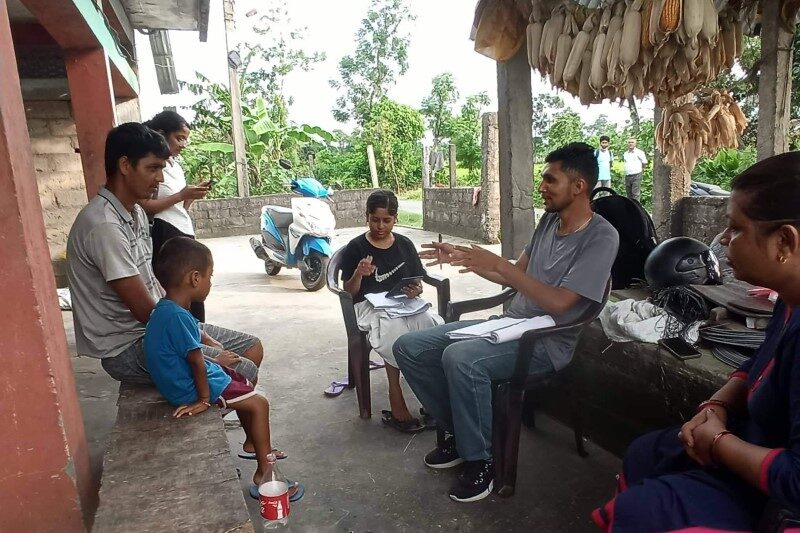
An international, multidisciplinary research team has launched a new project to improve the safety of fresh produce in Nepal by harnessing market-based approaches that integrate consumer and producer studies.
With a policy focus that prioritized food security and government investments in related areas, Nepal has experienced relatively higher productivity of some agricultural crops and lower poverty rates. Yet, 36% of children under five years old are chronically malnourished, and food production is only one side of the equation, says Aditya Khanal, associate professor of agricultural economics at Tennessee State University (TSU) and principal investigator (PI) on the new study funded by the Feed the Future Innovation Lab for Food Safety (FSIL).
“You can have enough food for people to eat, but if it’s not delivering its full nutritional value by causing foodborne illness, then that supply of food isn’t meeting the real needs,” Khanal says.
Although supermarkets are becoming more common in Southeast Asia, most consumers still buy vegetables from local growers and street vendors, or even from neighbors. As produce travels from field to market, it is susceptible to picking up and transmitting foodborne diseases. Consumers take on the risk without labels or guarantees, especially for vegetables eaten raw, says Ashok Mishra, co-PI and the Kemper and Ethel Marley Foundation chair in food management in the Morrison School of Agribusiness at Arizona State University.
Foodborne pathogens can be introduced onto fresh vegetables at any point during production, harvest, handling and packing, and preventing foodborne disease requires growers to exercise food safety practices, known as Good Agricultural Practices (GAPS), on their farms. Agnes Kilonzo-Nthenge, the team’s food safety expert and professor at TSU, says small-scale farmers are often not aware of risk factors on their farms, and therefore, food safety education and outreach are critically needed to persuade produce growers to adopt practices to avoid and reduce foodborne pathogens in their farm products. She notes that safer, fresh produce is possible with the use of a few strategic GAPS practices: hand washing, using aged rather than fresh manure, planting produce upwind and upstream from animal wastes, using clean and disinfected buckets for harvesting and testing for indicators of contamination.
This new research project is designed to address production challenges as well as the complexity inherent in trying to create systemic change in food safety behavior. As economists, Khanal and Mishra know that knowledge and awareness aren’t enough: this is where markets come in.
“We want to drive demand and supply for safer produce from both ends,” Khanal says. “To do that, we’re looking at the grower and consumer sides to create a two-way feedback mechanism that reinforces and increases food safety in Nepal’s fresh vegetable production.”
Researchers will start by surveying Nepali vegetable growers and consumers to assess the risk of foodborne disease in their households. With in-country lead and co-PI Ram Hari Timilsina, assistant professor at Nepal’s Agriculture and Forestry University (AFU), they will determine the baseline level of awareness about food safety and contamination in fresh produce, as well as if consumers are willing to pay more for produce handled using basic food safety principles.
Using this data, Mishra and Khanal can statistically model outcomes, such as whether food safety practices would generate higher income and financial security for small farmers. Those analyses can then help Nepali entrepreneurs and policymakers reach informed decisions on prioritizing food safety investments. In the study’s second year, researchers — including team members from AFU — will bring preliminary findings to key stakeholders by conducting food safety workshops for government institutions, universities and youth and female small-scale farmers.
Why start by training youth and women? Sramika Rijal, the team’s gender specialist and an assistant professor at AFU, says that over 74% of Nepali women are employed in agriculture — the majority in subsistence farming. Traditionally, Nepali women also have overseen the household food shopping and cooking. With this study, Rijal says they want to understand how gender roles and demographics contribute to vegetable production, consumption and status. They will also test the assumption that younger consumers tend to be more interested in and cautious about food safety.
“Ultimately, we want to equip youth and women in agriculture to participate in sustainable, safer food production and entrepreneurship,” says Rijal.
With this market-led approach, Khanal and his team aim to provide Nepali stakeholders with an evidence-based guide to incentivizing rapid changes in on-farm food safety. Because, whether policymaker or farmer, everybody is a potential consumer.
“Farmers are the starting point for food production,” says Khanal. “If we start there with these efforts, it will multiply down the chain.”
Sarah Thompson is a freelance writer for the Feed the Future Innovation Lab for Food Safety.

